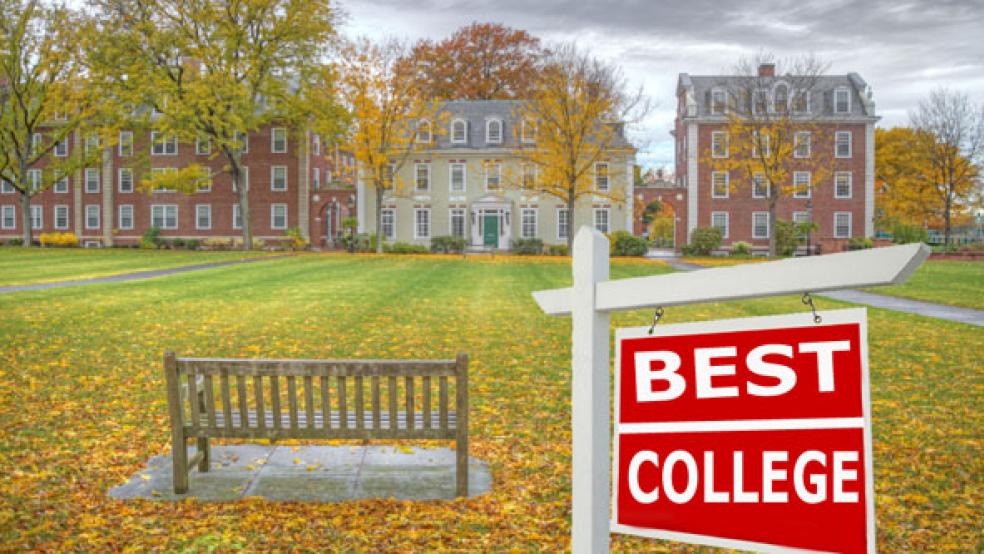College fundraising was up 9 percent last year, says the Council for Aid to Education, but there's a worrisome statistic: 17 percent of the $34 billion raised went to ten already wealthy institutions. The poorest of the ten is NYU, which already has an endowment of about $3 billion, 28th richest among American colleges and universities.
Inequality among colleges and universities seems to be increasing. Commentators on the left, right, and center now question whether massive endowments like Harvard's, a staggering $30 billion plus, serve higher education well. Felix Salmon and others consider Harvard "a hedge fund with an educational institution attached, the educational institution more than paying for itself in the tax exemption it confers upon the entire endowment."
Related: Can We Curtail Administrative Bloat on Campus?
Some, like Salmon, have called for revoking higher education's tax exemptions; others have called for taxing the wealthiest endowments; and still others have called on the best endowed colleges and universities to spend more on improving higher education nationally.
While they wait to see if any of that will happen, donors should consider whether flinging more dollars at the mountains of cash on which their favorite grantees sit will do much good.
$100 Million to Diversify Penn's Faculty
I understand that alumni will want to give to their own alma maters. One can't argue with gratitude. And for some donors, it will be nicer to have one's name on a bench at Harvard than on a building at Eastern Something State. Still, pouring one's charitable contributions into already flush institutions can have diminishing marginal returns.
Consider the University of Pennsylvania, which raised over $500 million this year. Last year, its diversity efforts were in the news. The University has committed $100 million new dollars, $20 million per year over 5 years, to diversify its faculty.
Related: Why Some Colleges May Put Themselves Out of Business
To put this figure in perspective, there were about 50,000 doctorates awarded nationwide last year, meaning that the university has committed enough to buy all the newly minted Ph.D.'s flowers, take them out for a nice dinner, and send them home in a limo. All that to attract minority and female candidates to what is already one of the most attractive places to work in the country.
Why not? They have the money. But many other campuses would kill to have $100 million in total endowment, let alone to spend on a program to bump racial and gender diversity up a few percentage points. Incidentally, last year's stories were about how Penn was not doing enough to promote diversity.
And speaking of diversity, donors should also consider the diversity of our higher education universe. For all the talk of the disruption that new tools, like Massive Open Online Courses, could bring to higher education, the institutions that stand to benefit the most from such disruption are the institutions that already have big brand names and deep pockets. It is ironic that the Davids in the David and Goliath story of MOOCs are Stanford, which spawned both Udacity and Coursera, and Harvard and MIT, which gave birth to edX.
Meanwhile, lower profile, small-endowment, places, with distinctive and excellent programs, are threatened by the same demographic and economic challenges that threaten colleges and universities that have less to recommend them. To be sure, donors will not give to institutions with which they have no connection, but it's not unlikely that institutions worthy of help are right in their neighborhoods.
Donor Intentions Often Ignored
Donors who are concerned about the teaching of core subjects like American history and composition, might look at this guide put out by the American Council of Trustees and Alumni. Donors concerned to preserve smaller institutions that emphasize undergraduate teaching and mentoring might look into the institutions in this group recognized by Colleges that Change Lives. No guide is perfect, and I have bones to pick with ACTA and CTCL. But it is easier than ever for donors to get an idea of which colleges and universities reflect their educational priorities.
Related: Here's Why Colleges Are Flunking Cost Control
To be sure, higher education giving is not easy. Donors must take care to clarify their intentions, for themselves and others, and give so as to ensure that their intentions are fulfilled. Frederic Fransen, the founder of Donor Advising, Research & Educational Services, in an article full of sage advice, explains that the endowed chair you fund for the study of free enterprise may be occupied by a professor who doesn't study free enterprise, and that the gift you mean to provide needy students with scholarships may get plowed into the general fund.
But thoughtfulness about giving encompasses not only ensuring that the purposes of one's gift are honored but also considering whether the recipient of the gift needs it to serve its mission. No doubt Bill Gates's children are grateful to him. But they probably do not express their gratitude by writing him a check. They know that their money is best spent elsewhere.
Of course, donors cannot be expected to seek out colleges and universities to give to and even small colleges of limited means had better have nimble and hardworking advancement staffs. But donors can pause before writing another check to Stanford, which raised almost a billion dollars this year, in order to make sure that Stanford students have even more events per day to choose from, rather than to a worthy institution in the neighborhood, so that it can continue to have a Department of Classics.
Jonathan Marks is a professor of politics at Ursinus College. This article originally appeared in Minding the Campus.
Read more at Minding the Campus:
Look What Freshman Composition Has Become
Role Model Affirmative Action: Not Needed, Not Legal
Dignity: New Verbal Weapon of the Left




